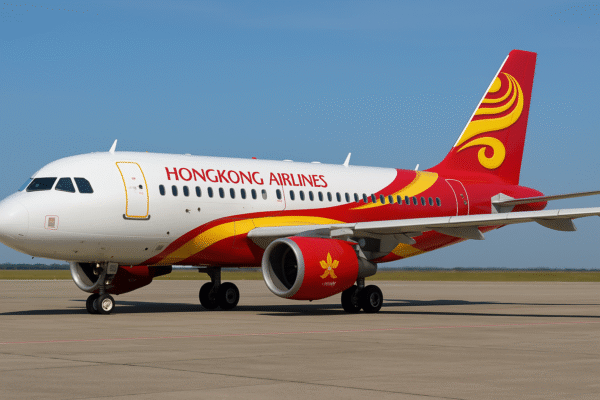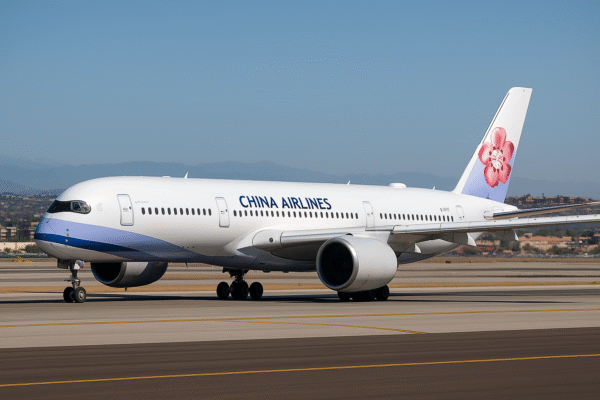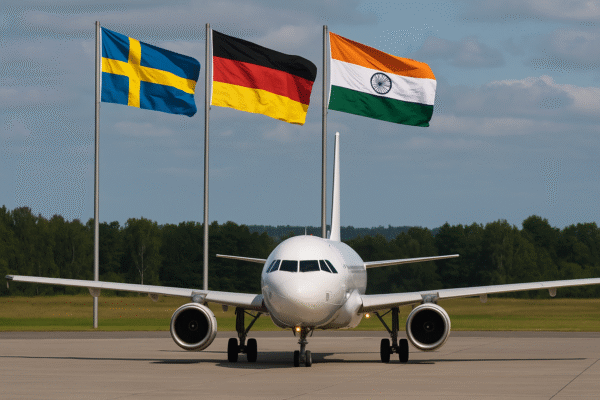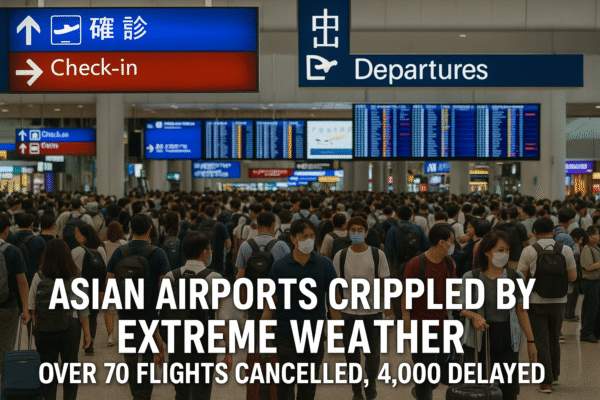Beijing – Tokyo – Hong Kong – July 23, 2025 —
Air travel across Asia plunged into chaos this week as widespread monsoon storms, dense fog, and turbulent winds caused massive disruptions at some of the continent’s busiest airports. Over 70 flights were cancelled and more than 4,000 delayed, grounding leading international carriers including Singapore Airlines, Emirates, Thai Airways, Air India, JAL, and Air China.
The ripple effect was felt most acutely at Beijing Capital International Airport (PEK), Tokyo Haneda (HND), and Hong Kong International Airport (HKG). With torrential rain, low visibility, and storm systems stretching from China to Southeast Asia, passenger terminals turned chaotic as thousands faced sudden delays or cancellations.
Major Disruption in China
China was hit hardest. According to data from the Civil Aviation Administration of China (CAAC), Shenzhen Bao’an International Airport recorded 444 flight delays and 8 cancellations, the highest in Asia that day. Other affected Chinese airports included:
- Guangzhou Baiyun: 339 delays, 12 cancellations
- Beijing Capital: 318 delays, 6 cancellations
- Kunming Changshui: 301 delays, 2 cancellations
- Xi’an Xianyang: 261 delays, 4 cancellations
- Shanghai Pudong: 213 delays, 4 cancellations
- Shanghai Hongqiao: 176 delays, 9 cancellations
- Chengdu Shuangliu: 188 delays, 3 cancellations
Much of the disruption was caused by heavy cloud cover and storm bands from Typhoon Gaemi, affecting operations over East and South China.
Japanese and Southeast Asian Airports Affected
Tokyo Haneda International Airport reported 138 delays, with flight schedules hampered by rain and poor visibility. Though cancellations were avoided, delays spanned both domestic and international services.
Singapore Changi Airport had 120 delays, mostly regional connections to Malaysia, Thailand, and Indonesia. Singapore Airlines advised travelers to check real-time updates via its mobile app and website.
Bangkok Suvarnabhumi experienced 94 delays and 4 cancellations, while Kuala Lumpur International Airport registered 260 delays. Thunderstorms and tarmac congestion affected multiple departures.
In Jakarta, 244 flights were delayed, with 7 outright cancellations. Indonesia’s BMKG Meteorological Agency attributed the severe disruptions to heavy tropical storms across Java.
South Asia and Gulf Travel Delays
Indian airports were not spared.
- Delhi Indira Gandhi International Airport recorded 62 delays and 2 cancellations
- Mumbai Chhatrapati Shivaji Airport logged 52 delays, largely attributed to low morning visibility and wet runway conditions
In South Korea, Incheon International Airport saw 198 delays with airlines including Korean Air and Asiana scrambling to recover.
Taiwan Taoyuan International Airport reported 70 delays and 1 cancellation, with flight congestion building throughout the afternoon due to scattered rain and narrow landing windows.
Airlines Severely Affected
Among the airlines most impacted were:
- Singapore Airlines: Regional and long-haul services experienced multi-hour delays across East and Southeast Asia.
- Air China and China Eastern: Schedules disrupted across all major Chinese hubs, including Beijing, Shanghai, and Guangzhou.
- Japan Airlines (JAL): Delay-prone at Haneda and Narita due to cloud layers and thunderstorms.
- Emirates: Several inbound Asia flights were delayed or rerouted, particularly to Bangkok and Tokyo.
- Thai Airways, Korean Air, Air India: Routes to and from Southeast Asia and India were severely impacted.
Airlines have advised travelers to rebook or opt for flexible tickets through digital platforms due to extended operational challenges.
Weather Trends Threaten Air Travel Stability
Meteorologists across Asia’s aviation bodies warn that such incidents may no longer be isolated. Monsoon instability and rising temperatures have compounded flight delays, especially during peak summer months. According to the World Meteorological Organization (WMO), climate volatility is increasing the frequency of low-visibility events, especially in urban airport hubs like Beijing and Delhi.
“These disruptions highlight the urgent need for enhanced weather forecasting and real-time air traffic control coordination,” said Prof. Lee Chan-woo of the Korea Aviation Meteorology Institute.
Government Advisories and Passenger Response
Governments across the region, including India’s DGCA, Japan’s MLIT, and China’s CAAC, have issued advisories recommending travelers monitor weather warnings, use airline apps, and book flights with flexible change options during July–August peak monsoon months.
Tourism boards in countries such as Thailand, Indonesia, and Singapore are also urging international tourists to confirm all travel arrangements and allow buffer time for transit.
Industry Outlook: More Turbulence Ahead?
With extreme weather events increasing across Asia, aviation insiders warn of a “new normal” for air travel disruptions. Airlines and airports are expected to invest further in AI-based weather prediction tools, enhanced de-icing and drainage infrastructure, and improved passenger communication systems to mitigate cascading effects.
The International Air Transport Association (IATA) stated in its July briefing that climate-related disruptions could cost Asian airlines billions annually if not addressed proactively.
Conclusion
As climate extremes intensify, Asia’s aviation industry is bracing for more weather-induced shocks. With over 4,000 delays and more than 70 flight cancellations in a single day, travelers, airports, and carriers alike must adapt. Passengers are urged to plan ahead, check weather forecasts, and monitor travel apps for the latest updates.
The skies over Asia may be turbulent for now—but smarter systems, better forecasting, and resilient infrastructure could be the key to navigating the storm.
For more travel news like this, keep reading Global Travel Wire




















